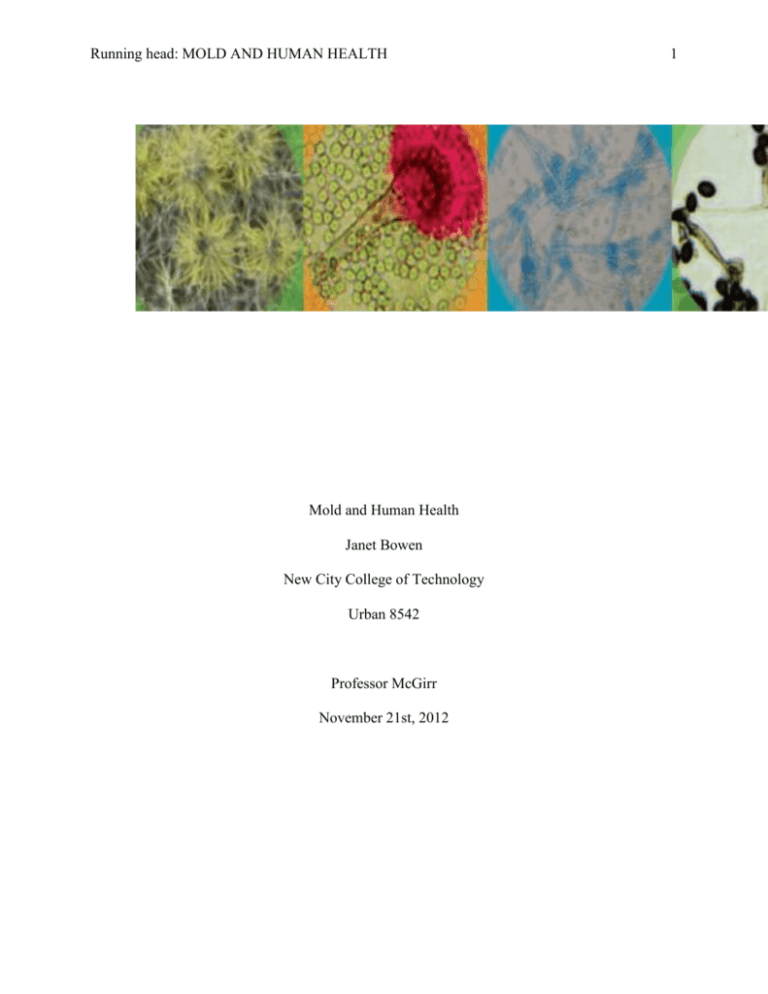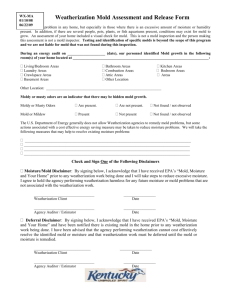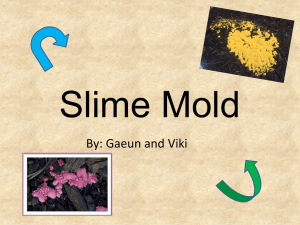PERRLA Version 6 For APA
advertisement

Running head: MOLD AND HUMAN HEALTH Mold and Human Health Janet Bowen New City College of Technology Urban 8542 Professor McGirr November 21st, 2012 1 MOLD AND HUMAN HEALTH 2 Mold and Human Health My topic mold and human health is important, because people living in private houses apartment buildings are all affected by the growth of something unusual growing under the surface. It is important that the public become educated about mold. Then each one of us will be better able to adapt to treating and killing mold before we become affected. According to the health and human development, mold grow in musty, damp areas that promote its growth and survival, mold is a fungus that will attach itself to certain types of materials such as drywall used in the construction of your house. “Molds include all species of fungi that grow multicellular filaments called hyphae. Over 100,000 types of mold are classified in the Zygomycota, Deutermycota, and Ascomycota, phylums” (Optis, Shaw et al 2012). As we Look at the effects of mold and the danger to human health, this can be very troubling. One must ask themselves, what is mold? Mold as we see it is the effect when a fungus starts growing in the homes of human beings. “Dampness and mold exposures in buildings are common with estimates ranging from 18% to 50% of buildings” (Mendell, Mirer et al 2011). What are the effects of molds? Molds have many effects, some of which are allergies inflammation, bronchopulmonary mycosis may develop. According to Mendel, Mirer 2011, consistent association between evident indoor dampness or mold and respiratory or allergen health effects in infants, children and adults. According to the center for disease control, Molds are fungi that can be found both indoors and outdoors. Wen, Balluz, 2011, states exposure to airborne and mold spores may contribute to various health problems. No one knows how many species of fungi exist but estimates range from tens of thousands to perhaps three hundred thousand or more. “Molds grow best in warm, damp, and humid conditions, and spread and reproduce by making spores” Wen, MOLD AND HUMAN HEALTH 3 Balluz, 2011). Mold spores can survive harsh environmental conditions, such as dry conditions, that do not support normal mold growth” (Wen, Balluz, et al 2011). Molds are found in virtually every environment and can be detected, both inside and outside, year round. Mold growth is encouraged by warm and humid conditions. Outdoors they can be found in shady, damp areas or places where leaves or other vegetation is decomposing. Indoors they can be found where humidity levels are high, such as basements or showers. People can intervene and protect themselves and their homes from mold growth, by controlling humidity levels and ventilating showers and cooking areas. If there is mold growth in your home, you should clean up the mold and fix the water problem. According to the EPA, Mold growth can be removed from hard surfaces with commercial products, soap and water, or a bleach solution of no more than 1 cup of bleach in 1. Some types of common indoor molds are: Cladosporium Penicillium Alternaria Aspergillus People that are sensitive to molds, experience symptoms such as nasal stuffiness, eye irritation, wheezing, or skin irritation. “Some people, such as those with serious allergies to molds, may have more severe reactions. Severe reactions may occur among workers exposed to large amounts of molds in occupational settings, such as farmers working around moldy hay” (Mendell, Mirer, et al, 2011). Severe reactions may include fever and shortness of breath. Some people with chronic lung illnesses, such as obstructive lung disease, may develop mold infections in their lungs. In 2004 the Institute of Medicine (IOM) found there was sufficient evidence to link indoor exposure to mold with upper respiratory tract symptoms, cough, and wheeze in otherwise healthy MOLD AND HUMAN HEALTH 4 people; develop asthma symptom. The IOM also found limited or suggestive evidence linking indoor mold exposure and respiratory illness in otherwise healthy children. In 2009, the World Health Organization issued additional guidance, the WHO Guidelines for Indoor Air Quality and dampness. Other recent studies have suggested a potential link of early mold exposure to development of asthma in some children, particularly among children who may be genetically susceptible to asthma development, and that selected interventions that improve housing conditions can reduce morbidity from asthma and respiratory allergies, but more research is needed in this regard. According to the Protection Agency (EPA) guide titled Mold Remediation in Schools and Commercial Buildings. If you have area to be clean more than 10 square feet consult the U.S. Environmental. Although focused on schools and commercial buildings, this document also applies to other building types. According to Wen, Balluz, 2011, one of the important confounding factors for Health Related Quality of life ( HRQOL) can be chronic diseases. Some are obesity, diabetes, asthma coronary heart disease and disability. However, the American Industrial Hygiene Association states that the available science on molds and their potential health effects remains under study, but considerable progress has been made. “Studies of qualitative and quantitative showed four findings of association between visible dampness and daytime wheeze, visible dampness and nighttime wheeze, mold odor and daytime wheeze, and mold odor and nighttime wheeze”(Mendell, Mirer, et al, 2011). Mendell, Mirer, 2011 states there are sufficient evidence of casual relationship, sufficient evidence of an association. “The US Centers for Disease Control and Prevention (CDC), the Institute of Medicine of the US National Academy of Sciences, the World Health Organization, and Health Canada all agree that living or working in a building with mold damage results in increased risk MOLD AND HUMAN HEALTH 5 of respiratory disease. Although there are several guidance documents available, there are no accepted national or International standards for mold investigation, evaluation or remediation. The American Industrial Hygiene Association (AIHA), however, has worked to translate the advice from the previously mentioned government agencies into state‐of‐the‐art inspection and sampling protocols, such as AIHA’s Recognition, Evaluation and Control of Indoor Mold book, also known as the Green Book. “All molds secrete hydrolytic enzymes that breakdown starch, cellulose and lignin into simpler substances that they can absorb” (Optis, Shaw, et al., 2012). “The ability of molds to decompose organic matter makes them invaluable components in the nutrient cycle” (Optis, Shaw, et al., 2012). If a person health concerns are primarily due to the fact that each person’s response to mold exposure is unique. “Negative health impacts of mold result when humans are in close proximity to mold in an enclosed environment where concentrations of mycotoxin are able to increase. Thus mold growth in building is particularly dangerous to human health” (Mendell, Mirer, et al., 2012). “Crucial condition exist when sufficient moisture are generated inside the homes in various ways. Rainwater may enter through openings or cracks in the buildings envelope, faculty eaves trough, defective plumbing, or in the clothes of residents and the fur of pets” (Optis, shaw, 2012). “The scientific complexities surrounding this issue would be a huge challenge, but the truth is that other, less scientific, difficulties dwarf them” Wen, Balluz, 2011). Media attention on this topic often creates emotionally charged circumstances, making scientific and professional judgment, as well as reasoned dialogue on this subject, very difficult. According to Wen, Balluz, 2011, in some instances, building owners have been known to ignore or dismiss potentially MOLD AND HUMAN HEALTH 6 serious problems. Importantly, many indoor air quality (IAQ) problems have nothing to do with mold, and buildings seldom have only one indoor environmental quality problem. It is essential to consider multiple sources of building IAQ problems instead of focusing on just mold concerns. In other instances, building occupants or public officials armed with mold sampling reports of dubious quality have reacted with alarm to potential threats, making risk communication very difficult. According to Optis, Shaw, 2012, dealing with an ongoing problem there are steps to take: Step 1 — Discard moldy or damaged materials “Wear a dust mask and gloves. Furnishings, such as mattresses, carpets, or sofas that got wet or have been stored in damp conditions should be discarded. Discard items that are no longer needed. Use this opportunity to reduce the amount of furnishings — this means fewer materials to absorb moisture and grow mold. Clothes and other items that have been cleaned should be stored in sealed plastic bags to prevent re-contamination” (Optis,Shaw, 2012). Step 2 — Vacuum “Proper vacuuming reduces the amount of mold spores. All surfaces in the home (floors, walls, ceilings, shelves) and non-washable furnishings (such as sofas, chairs, etc.) must be vacuumed thoroughly” (Optis, Shaw, 2012). Step 3 — Prevent “Keep moisture generated within the home to a minimum by conscientiously following the prevention steps presented in the next section” (Optis, Shaw, 2012). Step 4 — Clear wet areas Pull carpets and furnishings away from walls that get wet. Carpets and under pads that are moldy MOLD AND HUMAN HEALTH 7 should be cut out and discarded. Step 5 — Dry “Take steps to dry up areas that get wet. Monitor the relative humidity of the air. Use a portable dehumidifier, if necessary. Ensure that the condensate drain pan of the dehumidifier is emptied regularly” (Optis, Shaw, 2012).. Step 6 — Isolate “If the mold is limited to one area, isolate the area if possible. Cover the affected surfaces with plastic sheeting secured at the edges with duct tape. Note that this is only a temporary measure to minimize your exposure” (Optis, Shaw, 2012).. Step 7 — Clean “Healthy individuals can regularly clean “small” and “moderate” areas of mold, thus preventing these from getting out of hand, by following the safety precautions and cleaning guidelines” (Optis, Shaw, 2012). Step 8 — Seek professional help “Consider seeking professional help from trained IAQ investigators to identify appropriate remediation steps inside the home. Removing large amounts of mold will require the services of mold clean-up contractors” (Optis, Shaw, 2012).. Preventing mold Keep the home dry. Find and fix water leaks. Discard clutter and excess stored materials. Clean and maintain the home regularly. Encourage lifestyle practices that reduce moisture. Basic steps to prevent and reduce mold growth MOLD AND HUMAN HEALTH 8 Mold needs moisture to grow. Controlling the moisture and keeping the home dry prevents the growth of mold. Check your home for signs of moisture and molds. o Find out if water is coming in from the outside and if substantial moisture is produced inside the home, Fix any water leaks promptly. Think of the different ways moisture is produced inside the home (for example, cooking, bathing, plant jungle). Remove the moisture as it is produced by using exhaust fans. In the absence of fans, open windows for a short time, but note that the wind can push the moisture to other parts of the home. o Measure how much moisture is in the air. To find the relative humidity in your home, you’ll need a hygrometer. You can buy one at a hardware store or electronics store. A hygrometer costs from $10 to $60. Relative humidity in the home should be under 45 per cent in the winter (or lower to avoid condensation on windows). If necessary, use a dehumidifier to lower the relative humidity. Reduce the amount of stored materials, especially items that are no longer used. Molds grow on fabrics, paper, wood and practically anything that collects dust MOLD AND HUMAN HEALTH 9 and holds moisture (Optis, Shaw, 2012). Mold-proofing your home, room by room Basement or crawl space “Reduce the amount of clothes, paper and furnishings stored in the basement”. “Discard badly damaged materials. Eliminate clutter to improve air circulation. Only washable items should be stored”. “Dehumidify the basement during the warm months. Avoid carpets on slab-on-grade or below grade floors”. “Periodically clean the drain in your basement floor. Use half a cup of bleach, let it stand for a few minutes, then flush with plenty of water. Keep the drain trap filled with water. “Avoid standing water. Keep sump pits covered (you can use plywood wrapped with plastic) (Optis, Shaw, 2012).. “Regularly clean and replace furnace filters. Use a pleated one-inch filter, not a coarse filter” (Optis, Shaw, 2012).. “If you have a heat recovery ventilator (HRV), clean the filter inside the HRV often”. “If you notice molds or signs of dampness, such as water on your windows or wet spots” elsewhere, do not humidify. Disconnect furnace humidifiers that are no longer used “If you have electric baseboards, vacuum the units, or have a professional clean them for you. These are the important steps to take” (Optis, Shaw, 2012). “Each year there will be many more modification and changes in preventing molds and many new species may come in to light” (Optis, Shaw, 2012).. These are the essential steps for 2012. MOLD AND HUMAN HEALTH 10 References Alabama Department of Public Health http://www.adph.org/org/IAQ Louisiana Department of Health and Hospitals - Louisiana Public Health Institute http://www.stayhealthyla.org/mold.php Balluz, L., & Xiao, W. J. (2011). Association Between Presence of the visible in-house mold and health-Related Quality of Life in Adults Residing in Four U.S. States. Retrieved November 20th ,2012, from http://www.epa.gov/mold/moldresources.html http://www.cdc.gov/mold/ http://katysexposure.wordpress.com/2011/12/09/mold-issue-scientists-physicians-citizensrequest-joint-us-federal-agency-public-healthMendell, M. J., & Mirer, A. G. (2011). Respiratory and Allergenic Health Effects of Dampness, Molds and Dampness-Related Agents: A Review of the epidemiologic Evidence. Retrieved November 20th, 2012. Optis, M., & Shaw, K. (2012). Mold Growth in On -Reserve Homes in Canada: The Need for Research, Education, Policy and Funding. Retrieved November 20th, 2012





